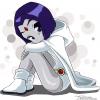Well Gail, for everyone's sake I am going to give a thumbnail sketch of herniated disc, also known as slipped disc and ruptured disc.
First of all it is unusual for a bad disc to show on an x-ray. With an x-ray they are eliminating broken vertebrae some bone diseases, etc. Only an MRI or Cat scan can really detect the herniated disc.
A disc is a jello filled bag that sets between each of the vertebrae in your back. It acts as a shock absorber for your back. The membrane around the jello is really tough but with enough strain and shock it can break and the jello comes pouring out and presses on the nerves and spinal cord in that area causing severe pain. That is a ruptured disc.
In most cases the membrane does not break but simply is forced out part way from between the two vertebrae. Where this bag pouches out again puts pressure on the nerves and spinal cord in the area.
There is no widely accepted way to do therapy, take medicine, or any other way to get the disc to go back to its original location except surgery. Now if the disc is only sticking out a small distance they can usually do an outpatient surgery. My wife had this one a very small herniated disc. Before the surgery she had trouble even walking or setting due to the pain. After the surgery (a one hour surgery including the recovery room she came out was coming out from under the anesthesia. She told the nurse she needed a bed pan. The nurse said no she could walk to the bathroom. She was completely able to walk there and back with no pain.
Now the more the disc sticks out the more the intensive the surgery. The disc can stick out far enough to compress the spinal cord severely. This can lead to nerve damage, the loss of the ability to urinate, severe pain, numbness, tingling in the legs or arm (depending on the location) and even permanent paralysis.
The normal procedure at that point is to go in with an open surgery and remove most or all the disc and have the two vertebrae fused together with bone and a metal plate. After all you can't have bone rubbing against bone with the disc gone. This is a painful recovery and has a long history of success. Unluckily because those two vertebrae are not able to flex (they are fused together) the stress of carrying things are passed on to the other vertebrae causing a second surgery to be needed, on average, after 11 years.
My wife has had the fusion once but recently opted for the second choice, arthroplasty, for her last problem. Arthroplasty, the insertion of an artificial disc, has gained in popularity during the last 10 years as the devices have improved and the techniques have matured. An open surgery is done through the belly area (6" incision), all the internal organs are moved to one side, the surgeon now has access to the front of the spinal column. The two vertebrae are jacked apart about 3" allowing the damaged disc to be removed and the artificial disc inserted. This surgery is very traumatic and takes around 3 months to even come close to normal function, considerable pain during those 3 months and a full year to fully recover. The up side is that around 60% regain full function of their back and with little or no residual pain afterward. Unluckily my wife's surgery went well but afterward she still had all the old pain and complications. Her dr said that because of all her prior surgeries she was overgrown with scar tissue which had effected her spinal cord and nerves. He said he spent more time removing scar tissue to get to the spinal column than it took to put in place the artificial disc.
Hopefully you can have the easier outpatient surgery. This is one time where age can be a benefit. As we age past 50 the membrane around the disc becomes harder and is less likely to rupture. It is more likely to be simply protruding and outpatient surgery may be the best choice. The MRI will tell.
![]() This made me cry again and I told the receptionist I would never see him again. Apparently this group does not prescribe anything, they only give shots.
This made me cry again and I told the receptionist I would never see him again. Apparently this group does not prescribe anything, they only give shots.![]()













